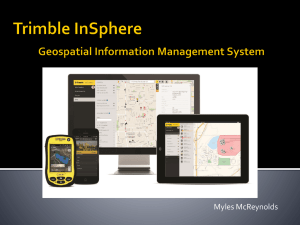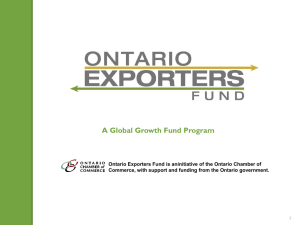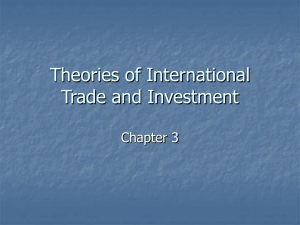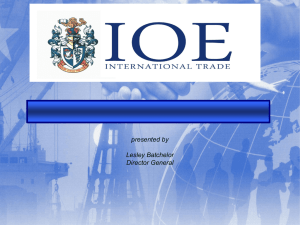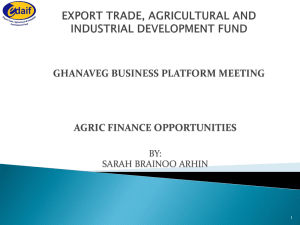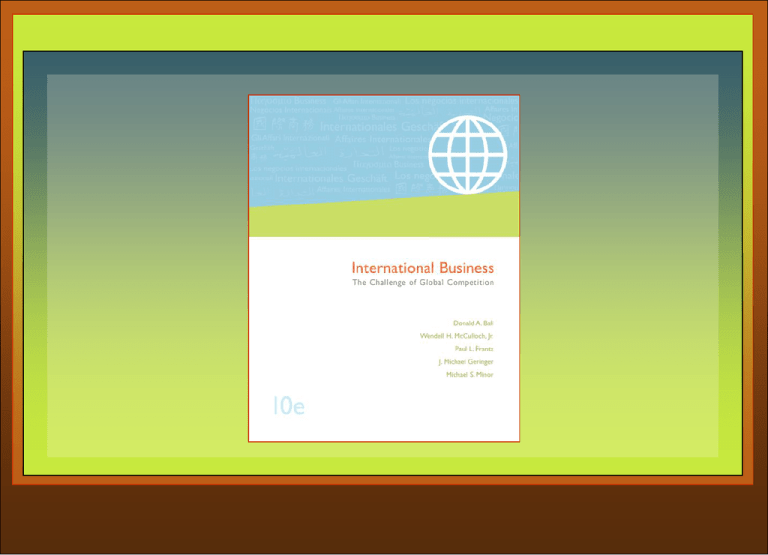
This chapter covers:
16
•Why firms export and
problem areas
•Sources of export
counseling
•Terms of sale
Export and Import Practices
•Sources of export
financing
•Foreign freight
forwarders
•Export documents
•Materials handling
•Import sources
•HTSUSA
International Business
by Ball, McCulloch, Frantz,
Geringer, and Minor
McGraw-Hill/Irwin
Copyright © 2006 The McGraw-Hill Companies, Inc. All rights reserved.
Chapter Objectives
Explain why firms export and problem areas of
exporting
Identify the sources of export counseling
Describe the main elements of the export sales assistance
program of the US Department of Commerce
Discuss the meaning of the various terms of sale
Identify some sources of export financing
Describe the activities of a foreign freight forwarder
Understand the kinds of export documents required
Identify import sources
Explain the Harmonized Tariff Schedule of the United
States (HTSUSA)
16-2
Why Export?
Reasons to export
To serve markets where
the firm has no
production facilities.
the local plant does
not produce the firm’s
complete product mix
To satisfy a host
government’s
requirement that the local
subsidiary export
16-4
To remain competitive in the
home market
To test foreign markets and
foreign competition
inexpensively
To meet actual or
prospective customers’
requests for the firm to
export
To offset cyclical sales of the
domestic market
Why Export?
16-5
To achieve additional sales
To extend a product’s life
cycle
To distract foreign
competitors that are in the
firm’s home market by
entering their home markets
To partake in the kind of
success the firm’s
management has seen others
achieve by exporting
To improve equipment
utilization rates
Most Common Mistakes
for New Exporters
Failure to develop an
international marketing plan
Insufficient commitment by top
management
Insufficient care in selecting
overseas distributors
Chasing orders from around the
world
Neglecting export business
when the home market booms
Failure to treat international
distributors on an equal basis
with domestic
16-6
Assuming automatic success
Unwillingness to modify
products
Failure to print service, sale and
warranty messages in local
language
Failure to consider use of an
export management company
Failure to consider licensing or
joint venture
Failure to provide readily
available service for the product
Why not export?
Two major reasons U.S.
firms give for not
exporting
Preoccupation with
the vast American
market
A reluctance to
become involved in a
new and unknown
operation
16-7
Problem Areas
Locating foreign markets
Payment and financing procedures
Don’t know where to start
Fear the complexity
Export procedures
Don’t know that information and government support
are available
Small Business Administration, Small Business
Development Centers, private consultants
16-8
Sources of Export Counseling
Trade Information Center
(TIC)
The federal government
has set this up as a first
stop for information
about all federal
export assistance
programs as well as
country and regional
market information
Visit web site at
www.ita.doc.gove/td/tic/.
16-9
International Trade
Administration (ITA)
Offers a wide range of
export promotion
activities that include
Market Access and
Compliance (MAC)
Trade Development
U.S. and Foreign
Commercial Services
(US&FCS)
Sources of Export Counseling
Small Business
Administration (SBA)
The Office of
International Trade of the
SBA works through
SBA district offices
SCORE programs
SBDC/CIBER
programs
US Export Assistance
Centers
16-10
Department of Commerce
Export Assistance Program
Foreign Market Research
After learning about the company and its products,
the international trade specialist may advise the
potential exporter to consult the National Trade Data
Bank (NTDB)
The NTDB provides
a comprehensive guide for new exporters
a source of specific product and regional information
for experienced exporters searching for new markets
The Foreign Traders Index
16-11
Department of Commerce
Export Assistance Program
NTDB
Available in University SBDCs
Can subscribe at www.stat-usa.gov
Trade specialist may suggest using the Trade
Opportunities Program (TOP)
Provides current sales leads from overseas firms
Leaders published in leading commercial newspapers
Can advertise in Commercial News at
www.cnewsusa.com
Assistance available from Dept. of Commerce at
www.usatrade.gov/uscs
16-12
Department of Commerce
Export Assistance Program
When small number of
potential markets identified
16-13
Research using Country
Commercial Guides
Must choose between
exporting indirectly and
exporting directly
Indirect way to test
market
Direct need overseas
distribution
Can use US
Commercial Service
Gold Key Service
Show and Sell
Four kinds of trade events that facilitate
international trade
U.S. pavilions
Trade missions
Trade specialists distribute at trade shows
Reverse trade missions
16-14
Focus on industry sector
Product literature center
Organized by the Dept. of Commerce
Visits to U.S. by foreign governments
Other Sources of Assistance
World Trade Centers Association
Nearly 300 worldwide
Access to online trading system
District Export Councils
Provided by Dept. of Commerce
Assist in workshops and arrange for consultants
State Governments
All states have export development programs
16-15
Export Marketing Plan
Essentially the same as the
domestic marketing plan
The plan should be specific
about
The markets to be
developed
The marketing strategy
for serving them
The tactics required to
make the strategy
operational
16-16
Marketing Mix
Foreign customers may
insist on one of the
following terms of sale
FAS (free alongside
ship, port of call)
CIF (cost, insurance,
freight, foreign port)
CFR (cost and freight,
foreign port)
DAF (delivered at
frontier)
Sales Agreement
16-17
Should specify the duties of
the representative and the
firm
Designation of
responsibilities for patent
and trademark
registration
Designation of whose
laws will govern
contractual dispute
Payment and Financing Procedures
Types of payment terms offered by exporters to
foreign buyers
Cash in advance
Open account
Consignment
Letter of credit
Documentary drafts
16-18
Export Payment Terms
Cash in Advance
When credit standing of the
Consignment
Goods are shipped to the
buyer is not known or is
uncertain
Open Account
When a sale is made on open
account
The seller assumes all of
the risk
Terms should be offered
only to reliable
customers in
economically stable
countries
16-19
buyer and payment is not
made until they have been
sold
All the risk is assumed by
the seller
Letters of Credit
This document is issued by
the buyer’s bank
which promises to pay
the seller a specified
amount when the bank
has received certain
documents stipulated in
the letter of credit
Export Payment Terms
Letters of Credit
Confirmed
Act of a correspondent
bank in the seller’s
country by which it
agrees to honor the
issuing bank’s letter of
credit
Irrevocable
Once the seller has
accepted the credit, the
customer cannot alter
or cancel it without the
seller’s consent
Air Waybill
Issued by carrier to be
presented as proof the
shipment has been made
Pro Forma Invoice
exporter’s formal
quotation containing a
description of the
merchandise, price,
delivery time, proposed
method of shipment,
ports of exit and entry,
and terms of sale
Export Payment Terms
Documentary Drafts
An export draft
is an unconditional
order drawn by the
seller on the buyer
instructing the buyer
to pay the amount of
the order on
presentation (sight
draft) or at an agreed
future date (time draft)
16-21
Export Financing
Private Source – Commercial Banks
16-22
Banker’s acceptance
Factoring
Provides working capital to manufacturers short of cash.
Is essentially discounting without recourse.
Forfaiting
Denotes the purchase of obligations that arise from the
sale of goods and services and fall due at some date
beyond the 90 to 180 days that is customary of factoring
Export Financing
Export-Import Bank
The U.S. Export Import
Bank (Eximbank)
Government agency
responsible for aiding
the export of American
goods and services
16-23
Variety of loan,
guarantee, and
insurance programs
Available to any
American export firm
regardless of size
Two types of loans available
from the Eximbank
Direct loans to foreign
buyers of American
exports
Intermediary loans to
responsible parties
Foreign government
lending agency that
relends to foreign buyers
of capital goods and
related services
Other Government Incentives
Overseas Private Investment Corporation
Offers investors insurance against
expropriation, currency inconvertibility, and damages from
wars or revolutions
Also offers specialized insurance for
American service contractors and exporters operating in
foreign countries
Foreign Sales Corporation
Special corporate form authorized by the federal government that
provides tax advantages for exporting firms
Free Trade Zones
An area designated by the government of a country for duty-free
entry of any nonprohibited good
16-24
Export Procedures
Foreign freight forwarders
act as agents for exporters
Prepare documents
Book space
Offer advice about
16-25
Markets
Regulations
Transportation
Packing
Supply cargo insurance
After shipment, forward
documents
Shipping Documents
Shipper’s Export Declaration
This document is
required by the
Department of Commerce
to control exports and
supply export statistics
Export License
General for most
products
Validated for scarce
materials, strategic goods,
technology, or war
materials
16-26
Export bill of Lading
Serves three purposes
a contract for carriage
between the shopper
and the carrier.
a receipt from the
carrier for the goods
shipped.
a certificate of
ownership
Insurance Certificate
Evidence shipment is
insured
Collection Documents
The most common documents for collection
Commercial invoices
Consular invoices
Issued by local Chamber of Commerce
Inspection certificates
16-27
Purchased from the consul and prepared in local
language
Certificates of origin
Add origin of goods, export packing marks, and a clause
stating good will not be diverted
Frequently required for grain, food, live animals
Export Shipments
Containers
Reduce theft and
handling costs
LASH (lighter aboard
ship)
Barges for shallow inland
waterways
RO-RO (roll on-roll off)
Can drive onto vessel
Air Freight
Can arrive in one day
16-28
Air Freight
Total cost components
that may be lower for
air freight include
16-29
Insurance rates
Packing
Custom duties
Replacement costs for
damaged goods
Inventory costs
When the total cost are high
for air freight, it may still be
advantageous to ship by air
when other factors are
considered
Production and
opportunity costs
The firm may be airdependent
The products may be airdependent
Spare parts and technical
personnel available
within a few hours
Importing
Ways to identify import sources
If similar imported products are already in the
market, visit a retailer and examine the product
label
If the product is not being imported, call the
nearest consul or embassy of that country
Use the electronic bulletin boards of the World
Trade Centers
Accidental importing also takes place
16-30
Customhouse Brokers
Independent businesses that handle import
shipments for compensation
Acting as the agent for the importer
Customhouse brokers bring the imported goods
through customs
They can arrange transportation for goods after
they leave Customs
They also need to know when imports are subject
to import quotas and how much of the quota has
been already filled
16-31
Importing
If the Quota fills the
importer must
Put goods in a bonded
warehouse or a foreign trade
zone
Abandon the goods
Send the goods to another
country
Automated Commercial
System (ACS)
16-32
Used to track, control, and
process all commercial
goods imported into the U.S.
Import Duties
Importer must know
How U.S. calculates
import duties
The importance of
product classification
The Harmonized System
Used by all developed
nations
Determines how goods will
be classified
Each product has its own
HTSUSA number
Import Rules
Disclose fully to the US
Customs Service all
foreign and financial
arrangements
Ask advice of a
customhouse broker
before making the
transaction
Calculate carefully the
landed price in advance
16-33
EXPORTS, IMPORTS,
and TRADE BALANCE
KEY ECONOMIC EVENTS
Economic activity improved for the United States and many of
its trading partners, contributing to increased U.S. exports and
imports in 2003.
U.S. exports grew for most manufacturing industry sectors,
recording an overall $21.8 billion increase during 2003, to
$651.4 billion.
U.S. imports grew for all manufacturing industry sectors,
recording an overall increase of $95.3 billion to reach $1.3
trillion in 2003.
The U.S. trade deficit expanded for most industry sectors, for
an overall increase of $73.5 billion in 2003 to $598.7 billion.
Agriculture was the exception, recording an increased trade
surplus of $1.1 billion to reach $3.8 billion in 2003.
KEY TRENDS
in U.S. Trade with Japan
The narrowing of the U.S. bilateral trade deficit
with Japan was augmented by a 9.8-percent
appreciation of the yen against the dollar.
Japan has been experiencing an economic upturn
since March 2003, after more than a decade of
deflation. This upturn appears to be more broadly
based than previous ones, with increased consumer
and corporate spending.
U.S. beef exports rebounded after incidences of
“mad cow disease” in Japanese herds and
mislabeling of imported beef in late 2001 and early
2002.
ExIm Bank
Ex-Im Bank Highlights: www.exim.gov/index.cfm
Russia Portal: Ex-Im Bank Opportunities in Russia
Mexico: web portals for U.S. exporters y los
compradores de Mexico
Protecting the environment
Business Opportunities in Southeast & Central
Europe
Recent Newsletter
Video - Product Overview
News & Information by E-mail
Iraq
Ex-Im Bank Support for U.S. Exports to Iraq

